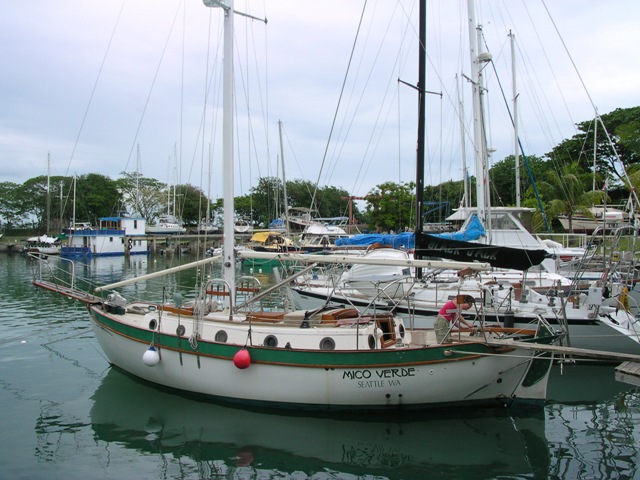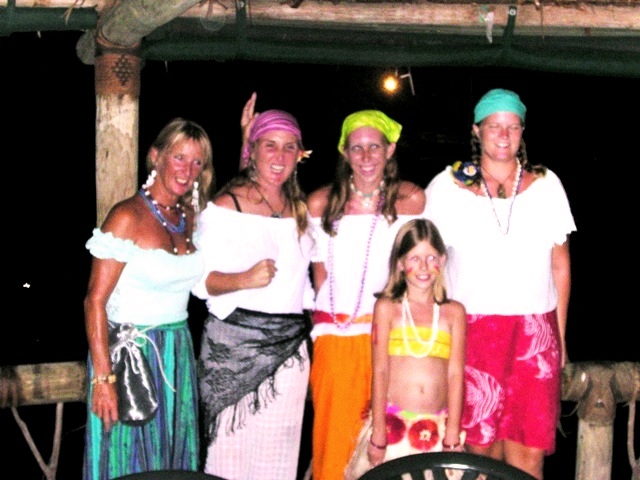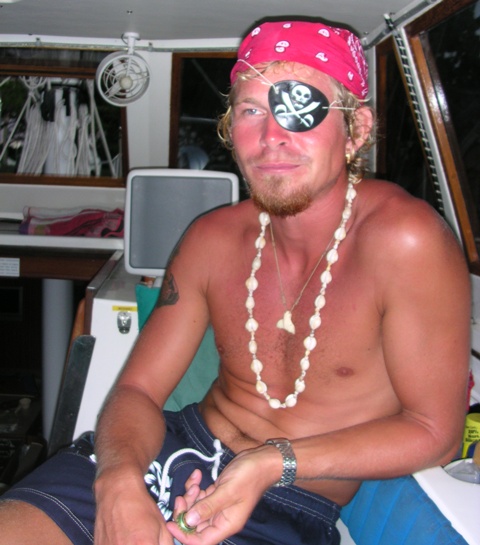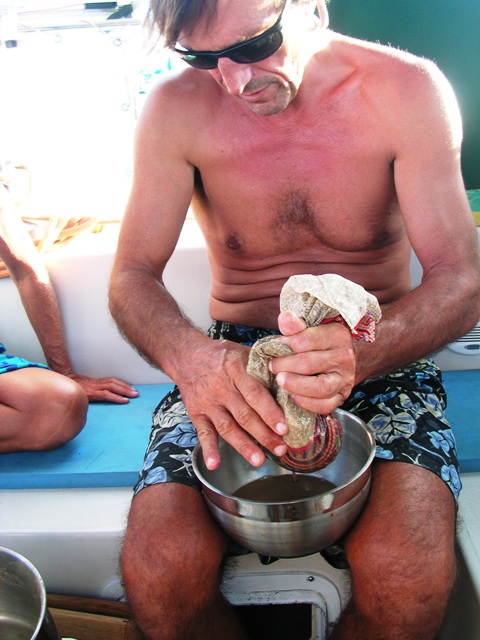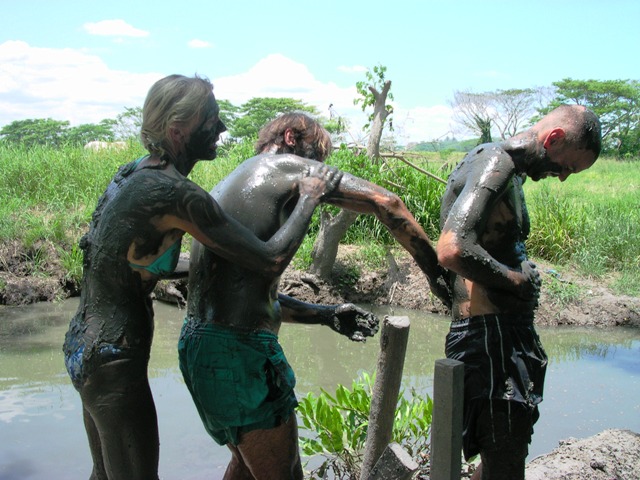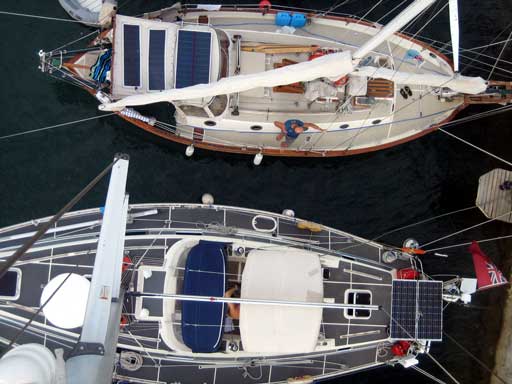 |
|||||||||
|
|
|
|
|
|
|
|
|
||
|
|
|
|
|
To read about our Pacific Ocean crossing to the Marquesas, click here. Season Three: South Pacific For our journals in sequential order, read from the bottom up or use these links to jump around the page. When you reach the end of an entry, click on the "Next journal entry" hyperlink to go to the following entry. October 27 - Fiji (Vuda Point) November 10 - Fiji (Vuda Point) November 17 - Fiji (Vuda Point)
Vuda Point Marina, Fiji (Steph) Well, the boat is all put away and as ready as she'll ever be to wait for us to return. We are not thrilled about leaving her in the cyclone belt during the cyclone season, but we have high hopes for the capabilities of Vuda Point Marina and its staff. They haven't lost a boat yet, so here's hoping that Mico is not their first. As our departure day grew close, we started getting very nervous about leaving her here. I had observed that reaction in other people who had already left for home, so I wasn't too surprised. But, it is time to go and the best we can do is just prepare her and leave her in good hands. The last days leading up to our departure were pretty frenetic. I went through all our lockers and cleaned them thoroughly, managing to find willing recipients of a lot of stuff we never use. The R Factor was happy to take the canned chicken and turkey from Mexico that neither Warren nor I can stand, the canned broccoli that had become the most dreaded canned vegetable in existence, and our last unopened can of Kraft Parmesan Cheese, the most precious commodity within 800 miles. I rinsed the walls and ceilings in a vinegar and water solution, in an effort to combat mildew. Warren cleaned and dried out the bilges, and gave the hull a good, thick coat of wax. On our last day, we took down all the sails and the dodger, and transferred them to the cozy forecastle below.
Mico looking pretty bare without her sails or dodger We also found out, on our last day, that the caretaker we hired until June is moving to Tonga in March. Great. And, of course, he was delivering a yacht and unable for us to contact so that we could get some reassurance that Mico will be cared for while we're gone. But the marina staff reassured us that they'll help us find an alternative caretaker when March rolls around, and they'll take care of Mico in the event of a cyclone. We are trying to stay positive, and hope Mico is still in good condition when we come back.
Vuda Point Marina, Fiji (Steph) Today marks one more week before we backtrack our entire journey moving at a rate of 600 mph. We've managed to tackle our project list on official Fiji Time, which means a little bit of work and a lot of play. I'll recount the highlights of the last two weeks for you ... Halloween was a festive affair. It has been discovered that unless you've come prepared with costumes on board, the best costumes most cruisers are likely to improvise are pirate outfits. No joke. Out of four different yachts, a total of nine people, only two of the group were not pirates. Warren gets points for originality (although not for energy expended) dressing as a doctor in his Costco-purchased scrubs, and little Jacqueline from R Factor sewed her own costume and painted her face to create a kind of tribal hula dancer.
Las Piratas at the yacht club on Halloween
Christopher Atkins reprises his role in The Pirate Movie. This swarthy fellow is crew from Angels-Viking, another Norwegian yacht. We hypothesize that there are no Norwegians actually in Norway, as they are all out cruising. On our way into Lautoka the next day, we spotted our dear friends Maggie and Tom from Aurora B. I yelled for the taxi driver to pull over and we ran out of the car yelling and jumping with excitement. We hadn't seen them since mid-June in the Marquesas. Since we met them in San Diego a year ago, we've rarely managed to synchronize our times in port. But we've had them all to ourselves for the last few weeks. They invited us out to their boat for our first taste of kava, something they've sampled in a number of different Indo-Pacific islands. Tom's a psychologist who works closely with psychiatrists, so we got a detailed explanation of kava's chemical effects on the brain's receptors. As the night wore on, we got a bit less explanation and a lot more yawns, drooping eyelids, and mutterings of "Are you stoned? I am definitely stoned." Kava's physical effects are that it immediately has a subtle numbing effect in your mouth, and later in your legs. Mentally, you just mellow out big time and eventually have the best sleep you've had in eons. I likened the flavor to "Essence of Pottery Shop," or basically, the scent of a gift shop that stocks dried flowers, woven baskets and hand-spun pottery. Or, to put it simply, dirt.
Tom mixes up some tasty kava Our next outing with the crew of Aurora B saw us wandering via taxi in the hills outside of Nadi. All of us being from the mountainous region of the Pacific Northwest of the U.S. and British Columbia, we have quite the affection for hot springs. Speaking personally, my experience with them has been in the cool rainforest of the Olympic Peninsula, under a thick coniferous canopy. The naturally hot pools are soothing and relaxing, and the perfect temperature on a cool day. Now, imagine hot springs of a similar temperature, but exposed to the relentless sun at 17 degrees latitude South. Fiji reaches temperatures around 90 degrees F at this time of year. Does that still sound refreshing? Actually, there were four different pools that got cooler the farther away they were from the origin of the springs. The last pool was the most fun, as its mud is touted as a cleansing skin treatment. We entered the pool cautiously, as the bottom has an extremely thick layer of soft mud and accumulated leaves and twigs. It felt pretty gross, to put it plainly. Once we adjusted to sinking in mud up to our thighs, we started slathering each other from head to foot. As the mud dried, we resembled elephants, with every dermatological flaw enhanced in dull grey. But after rinsing off, our skin was noticeably softer and felt super clean.
Mud-slinging conga line
Don't drink the water I've also been learning to scuba dive! Getting my open water certification has been a goal since we started this trip, and what better place is there to do it than Fiji? With all the time we're spending here in Vuda Point, we figured this was my chance. Plus, it's much cheaper here than it would be in the States. So, I am now officially certified! Warren and I have done a few dives together, viewing the wreck of a B26 bomber airplane and some incredible hard and soft coral formations. I am looking forward to trying a cold water dive when we get back to Seattle. The latest highlight has been our friends Quentin and Mark from sy Skardu arrived at Vuda Point just yesterday. We got to know them well when we shared an incredible week together in Suwarrow. We never managed to cross paths again until now, almost two months later. Besides sharing stories of the past few months, we had a wild night made up of mojitos and a fruitless search for a late-night bar. We're heading over to their boat in a few minutes for Mark's homemade eggplant and okra curry and a viewing of the last of the Star Wars trilogy. They leave Vuda Point tomorrow, soon to depart for New Zealand. We hope to see them again next year in some remote anchorage.
Lastly, Warren and I have had fun trying to pick up some of the Fijian language. The employees of the marina are all very friendly and receptive to tutoring us. Favorite phrases are "Seqa na leqa" (pronounced senga na lenga), which means "no worries;" and "Venaka" or "Venaka vakalevu" which means "thank you." I also found out that in the dialect of the Yasawa island group, "verde" means rear end. Signing off, this is the crew of the Little Green Monkey, aka Monkey Butt.
Vuda Point Marina, Fiji (Steph) We've arrived at Mico's home for the next seven months. We left Suva on Tuesday morning and had a gorgeous sail that day. Fiji had been stuck in a giant wind hole for more than a week (see our passage notes in the previous journal entry), so the seas were almost flat calm, with a barely perceptible swell. Wind was light, but we managed to move along at about 4 knots, enough to ensure we'd make it to Vuda Pt. before sunset the following day. The wind died down in the late afternoon, however, and the night was a pretty uncomfortable one as we alternated between motoring and trying to sail with the drifter, while dodging numerous freighters that seemed to have no one at the helm. We managed to sail through most of the morning, and made good time. We were in sight of the marina by 133o.
Chillin' in the light winds on passage to the west side of Viti Levu Note to anyone that plans to visit Vuda Point Marina in the future: Approach slowly, with every pair of eyes watching! Not until we were very close to the entrance did I realize that we were about to cruise right up onto the fringing reef surrounding the entrance. Upon very close inspection with the binoculars, I realized there were some very tiny white flags leading up to the extremely narrow entrance. Warren was at the helm and couldn't make out the flags, so finally surrendered the helm to me. We slowly motored through the entrance, with the reef uncomfortably close on either side of us. We came to the main basin, where a guy in a dinghy waited to help us maneuver into our "slip" and tie us off. Vuda Point is a marina engineered specifically as a hurricane hole, so if a cyclone approaches, boats are chained to both the land and to a center buoy. As we entered the marina, Warren joyfully yelled out, "Tequila's still here!" If you'll recall from our Society Islands logs, Quinn, the skipper on sy Tequila is one of Warren's favorite boat buddies. We haven't seen him in over two months, when he departed from Bora Bora. We knew he was in Fiji, but planned soon to leave for Australia. He wasn't around as we checked in and cleaned up, but as we met the employees at the marina, it turned out Quinn is already a legend. No surprise there. (wojo) Happy birthday Stephanie!! We did manage to have one last hurrah with Quinn in Fiji. By the time we arrived they were getting ready to elect him as joint mayor of Nadi and Lautoka. Seriously, he made some impact on the local area and I'm surprised he was allowed to even leave in the end! Every local woman between the ages of 19 and 30 was in love with him and promising him part of their 10 acres. He's also a junior member of the local "dirty ol' man club" at the Vuda Point Yacht Club. Quinn and his crew Dave sailed out of Vuda today and should have fair winds for at least the next week on their way to Sydney. It's quite a long haul and will take around fourteen days to complete, non-stop. When I watched Tequila head out through the pass I felt like I was eight years old again and my best friend had just moved to a different town. It's hard to imagine that the next time we see each other it'll be back in Washington. Have I mentioned yet that the people you meet out here are more than enough reason to ruin your life and cruise the seas? Quinn had a major stroke of good fortune while passing through Tonga. One day at anchor a swarthy South African singlehander dropped by and mentioned that he'd painted Tequila several years ago. After a couple of beers they decided that Dave would give Quinn a hand getting her all the way west to Oz before the cyclone season hit. Checking out the trip log today I noticed that we've made 9,967 nautical miles since leaving Seattle. More than 5000 of which have occurred just this season. Not bad for a 32' boat. Take that all you Hallberg-Rassys that never sail more than five miles off the coast!
Dave, Cap'n Quinn and Steph before cutting the lines on Tequila
Goodbye Fiji, Hello Oz (Wojo) We've just folded space (traveling without moving) from Pago Pago. Eight days in all, this was one of our longer passages. At least we made it out of Pago Pago! We did more on the day we left than we'd done in the previous three weeks just to get moving finally. We did a test run to try to recover the anchor since she'd not moved since the big blow the week before and I was sure she was fouled. We did get the hook back without any problems, surprisingly -- it was completely buried in the mud up to the shackles. A word about the clear in/out process in Pago Pago. The fees they charge are completely ridiculous! Visiting a U.S. territory as U.S. citizens we had to pay $125 in customs and harbor fees (the most we've ever paid). This is not the way to encourage tourism and yachtie dollars. The harbor fees are especially a joke. There are no services provided to visiting yachts, despite the $50 fee. No potable water, the "dock" you are required to pull up to upon first arrival is just a big, hull-damaging concrete wall, and the only dinghy dock available is generously offered by a liveaboard who owns the little piece of floating dock he's tied to.
Pago Pago escapees Dave and Rosy from sy Chardonnay Overall the winds this passage were the lightest we've encountered in the entire season. The first day out we had some of the best conditions I've ever sailed in and we made a solid 140 nm noon to noon run. The next day a trough popped up out of nowhere on the charts and we were reaching in wet and rolly conditions in 25 to 30 knots. Day three brought a low directly into our course so we opted to head north and put 300 miles between us and the low. This meant heading north of the Tongan island Niuetoputapu ("New Potatoes") to steer clear. As soon as the low materialized it completely knocked out the winds in our area as they were countering the usual 15 kt southeasterlies. For the next days we did our best to sail along in at most 5 to 10 knots of breeze. We were completely becalmed at one point and just drifted around a bit and took it easy near the atoll of Niua Fo'ou. Even in the doldrums during our Pacific crossing, I don't remember having been that becalmed. We could clearly watch giant mahi mahis swimming underneath the boat, enjoying the shadow we cast. The water was like glass! Steph dropped a 7-Up can over the side and an hour later it was only about 30 feet behind the boat. (It's generally accepted that paper and cans get dropped over the side when at sea, as they'll eventually break down. We usually fill the cans with water so they'll sink.) Our original plan was to sail into the south passage of the Fiji group and make a straight line for Lautoka on the west side of the island. But, after eight days it was time to put in somewhere for a rest. Due to the wind angle we entered Fijian waters through the north passage of Nanuku. I'd always read that the nav buoys can be sketchy in these waters, so we hove-to for the night 20 miles out before entering the reefs and islands of the north Koro Sea. After a couple days beating down south we finally pulled into Suva pass around 1100 today. The pass is very straightforward and quite wide but there are enough wrecks to pass on the way in to keep you on your toes. We contacted port control on 16 to let them know we'd want to clear in soon and set a time to see the health officer. On the chart there's a quarantine anchorage that's near the yacht club. In previous years the health officer had to visit the yacht before you met with the other officials but now they just want you to anchor, take the dinghy into the yacht club and meet the whole group at the office at King's Wharf. In fact, I'm not sure it's even necessary to call before coming in, as all the guides say. There were many, many forms to file with the customs, immigration, quarantine and health officials at the wharf but the whole process only took about an hour. We were now free to enjoy being back on land. The day before coming into Fiji we both started to get really excited because coming here was pretty spur-of-the-moment (see explanation below) and we both knew absolutely nothing about it. Suva really feels like a big city but nearly everyone you pass on the street gives you a warm smile and a "Bula!" The population is about half east Indian and half native. There's a huge Hindu holy day coming up at the end of next week and the town is buzzing. We had a good walk and did some provisioning. We managed to find the new movie theatre and it's even playing Serenity!! The yacht club here is very nice and as friendly as everyone always reports. A good place to tie up the dink and enjoy some cheap and excellent Fiji Bitter.
The rudder of HMS Bounty in the Suva museum (Steph) Note on our previously unplanned visit to Fiji: Our original plan for the end of the season was to visit Tonga, and then head down to New Zealand for the cyclone season where we hoped to find jobs for a few months. Yes, the four-letter-word rears its ugly head: w-o-r-k. You've asked us before how we're funding this trip, and we were honest. We've spent the money we saved, and always knew that it wouldn't last forever. We decided to throw out a net to see if we could catch any temporary job offers, both in NZ and back home. Warren managed to get a bite back in Seattle, so we've decided to leave Mico in a hurricane hole here in Fiji while both of us go back to the States to work for a few months. I also have to admit to a tiny bit of pride for having to go back. There are very few cruisers out here in our age range (early 30s). Most cruisers we meet are retired. They get to stay out here as long as they want, or at least a few years, before they plan to go home. But the majority of people we've met that are our age have some kind of plan to beef up the kitty with work. I think it's pretty cool that we're out here enjoying ourselves now, rather than waiting until we have all the cash in hand. For those people who think they need to save for 5 years before they start cruising, just know that you're wasting precious time now. Just go!
American Samoa,
Tutuila Island (Wojo) After living inside a convergence zone for the past week I can safely say that our love affair with this island is quickly diminishing. The weather report (from our local NOAA station) had clearly stated 15 - 20 knot NW winds on Thursday but what we've actually had in the past 48 hours has been 30 - 55 knots of SW wind in Pago Pago harbor. Ugh ...
The Korean fishing fleet trying to keep their raft together during the storm This is the most wind we've ever encountered, even at the marina during a Seattle winter. Things just kept getting worse and worse for the fleet here. In the end everyone was OK but most boats dragged at some point, got fouled or had some other calamity, usually in the middle of the night. Our close call was early on when the wind changed direction and we found ourselves bumping up next to a big steel sailboat that weighs considerably more than we do. But they were on deck (after abruptly ending the kids' birthday party they were throwing), as were we, and after adjusting our respective scopes (the amount of anchor chain we had out), everything was fine. At 5:00 am, we watched as a singlehander's boat dragged. We felt unable to leave our boat to help him out, so we put out a general call to the anchorage. Elizabeth, 6 feet of very capable Norwegian, responded and helped him get his anchor up.
Tradewind-High Girl versus Tropical-Depression Man BTW -- due to a long lapse in web updates we received this strongly worded note from Steph's cat Spike via mom Jill:
American Samoa,
U S of A!!
(Steph) Warren stated it perfectly: If it's possible to be
culture-shocked in your own country, this is the place. We've spent
most of
Local kids at the produce market. They recommended the vaitalu, a hot banana and tapioca soup that Steph was happy to sample We had expected American Samoa to be awful, because the place has a very bad reputation with cruisers. The harbor smells bad because the Starkist tuna canneries operate here. The water is polluted and teaming with trash. But, in my opinion, the island is beautiful. There are soaring peaks of bright green tropical foliage, jagged cliffs and rocky outcroppings on the coast, waterfalls and coral reefs. And hey, let's face it, speaking our native language with the locals is a welcome novelty. Although many of the locals still speak Samoan with each other.
The local produce market sets up for another Saturday morning A looong footnote -- when we started this trip, we expected to encounter some people that just don't like Americans. Sadly, it's something you encounter if you travel enough. I'm not going to go into the various reasons why that may happen, but let's just agree that it can happen sometimes. But to give you an update, we haven't really had any negative run-ins. The people that we met in French Polynesia were incredibly friendly, generous, and curious about us. I don't think either of us have a negative experience to relate, regarding our status as Americans. We thought we might get some flack from cruisers of other nationalities, but the only questionable American stereotype we encountered was when a German cruiser said to us, "Americans aren't very adventurous." He made that statement in the Marquesas. Never mind that we're American and were sitting there at the same table as he was, having arrived there by the very same method. But I digress.
Pago Pago harbor Warren and I have both approached every person we've met with respect and an eagerness to learn something from them. We never mastered the Marquesan language, and don't have the ability to distribute zillions of gallons of gasoline to people on remote islands. But we are curious about the people we meet, and I think that they appreciate it. When an American cruiser told us that he wasn't going to bother learning any French because he would only be in French Polynesia for three months (three months!!!), I was incredulous. No wonder people have the opinions they do about Americans! But the opportunity to change those opinions is there, and personally, I look forward to doing something about it.
Village in Tutuila The point of this topic is that arriving here, all of a sudden we're encountering all this anti-Americanism. But surprisingly, it's from the American cruisers. I've never considered myself one of the Patriot Police, but I am starting to get a little annoyed with these people. One guy told me that he is going to get his boat painted so that it will cover up his port of call (San Francisco), because he doesn't want anyone to know that he's an American as he continues to cruise. I asked him why, and he responded that it's because Americans are not liked in many countries. When I asked him if he doesn't view that as an opportunity to change some people's minds, he just stared back at me, speechless. Get a backbone, for cryin' out loud!! Another cruiser told me that after arriving here on American soil for the first time in years, she'd rather die of cervical cancer than go back to the U.S. I am not making that up.
Steph and Elizabeth on a kooky palm Sure, being in these exotic locales is an experience I'll never forget. I'm so glad that I have this rare opportunity to be out here. But at the same time, I appreciate my own country a lot more. I don't mind flying the American colors from our stern. (W0jo) South Pacific good. Minnesota bad.
Irish biology lesson on the beach
Keelin, Maddy and Oran get the cream
Greetings from 'round the world from S/Ys Nike (Ireland), Mico Verde (US), Blaatur (Norway), Ohana (US), Ventana (US) and Lear Jet (US) To read previous posts, check out the Journal. Do you want to be alerted when we update? Please email micoverde@gmail.com to let us know. |
||||||||||
|
|
||||||||||
 |
 |
 |
 |
 |
||||||
|
|
||||||||||
